Basketry Is a Type of Fiber Art True or False
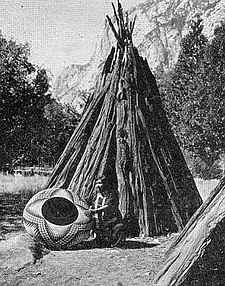


Basket weaving (also basketry or handbasket making) is the process of weaving or sewing pliable materials into iii-dimensional artifacts, such as baskets, mats, mesh bags or fifty-fifty furniture. Craftspeople and artists specialized in making baskets may exist known equally handbasket makers and handbasket weavers. Handbasket weaving is also a rural arts and crafts.
Basketry is made from a variety of fibrous or pliable materials—anything that volition bend and class a shape. Examples include pine, straw, willow, oak, wisteria, forsythia, vines, stems, animal hair, hibernate, grasses, thread, and fine wooden splints. At that place are many applications for basketry, from simple mats to hot air balloon gondolas.
Many Indigenous peoples are renowned for their basket-weaving techniques.
History [edit]
While basket weaving is one of the widest spread crafts in the history of whatsoever human civilization, information technology is hard to say merely how sometime the arts and crafts is, because natural materials like wood, grass, and fauna remains disuse naturally and constantly. So without proper preservation, much of the history of handbasket making has been lost and is merely speculated upon.[ citation needed ]
Middle East [edit]
The earliest reliable show for handbasket weaving engineering in the Centre East comes from the Pre-Pottery Neolithic phases of Tell Sabi Abyad 2[1] and Çatalhöyük.[2] Although no actual basketry remains were recovered, impressions on floor surfaces and on fragments of bitumen suggest that basketry objects were used for storage and architectural purposes. The extremely well-preserved Early Neolithic ritual cave site of Nahal Hemar yielded thousands of intact perishable artefacts, including basketry containers, fabrics, and diverse types of cordage.[3] Additional Neolithic basketry impressions have been uncovered at Tell es-Sultan (Jericho),[4] Netiv HaGdud,[3] Beidha,[5] Shir,[6] Tell Sabi Abyad III,[7] Domuztepe,[viii] Umm Dabaghiyah,[9] Tell Maghzaliyah,[eight] Tepe Sarab,[x] Jarmo,[11] and Ali Kosh.[12]
The oldest known baskets were discovered in Faiyum in upper Egypt[thirteen] and have been carbon dated to betwixt x,000 and 12,000 years quondam, earlier than any established dates for archaeological evidence of pottery vessels, which were too heavy and fragile to suit far-ranging hunter-gatherers.[14] The oldest and largest complete basket, discovered in the Negev in the Middle East, dates to 10,500 years old.[15] However, baskets seldom survive, as they are made from perishable materials. The most common prove of a noesis of basketry is an imprint of the weave on fragments of clay pots, formed by packing clay on the walls of the basket and firing.
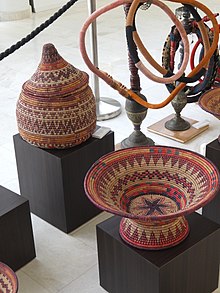
Woven baskets made of rush and palm fronds
Industrial Revolution [edit]
During the Industrial Revolution, baskets were used in factories and for packing and deliveries. Wicker furniture became fashionable in Victorian gild.[ citation needed ]
World Wars [edit]
During the Globe Wars some pannier baskets were used for dropping supplies of ammunition and food to the troops.[sixteen]
Types [edit]
Basketry may exist classified into iv types:[13]
- Coiled basketry, using grasses, rushes and pine needles
- Plaiting basketry, using materials that are broad and braid-like: palms, yucca or New Zealand flax
- Twining basketry, using materials from roots and tree bark. This is a weaving technique where two or more flexible weaving elements ("weavers") cross each other equally they weave through the stiffer radial spokes.
- Wicker and Splint basketry, using materials like reed, cane, willow, oak, and ash
Materials used in basketry [edit]

Bending vines for handbasket construction in Pohnpei
Weaving with rattan core (also known every bit reed) is one of the more pop techniques being skillful, considering it is easily available.[13] It is pliable, and when woven correctly, it is very sturdy. Also, while traditional materials like oak, hickory, and willow might be difficult to come by, reed is plentiful and can be cut into any size or shape that might be needed for a pattern. This includes flat reed, which is used for nigh foursquare baskets; oval reed, which is used for many circular baskets; and round reed, which is used to twine; some other advantage is that reed tin can also be dyed hands to look like oak or hickory.[ commendation needed ]
Many types of plants tin can be used to create baskets: dog rose, honeysuckle, blackberry briars once the thorns have been scraped off and many other creepers. Willow was used for its flexibility and the ease with which it could exist grown and harvested. Willow baskets were commonly referred to as wickerwork in England.[17]
H2o hyacinth is used every bit a base material in some areas where the plant has get a serious pest. For example, a group in Ibadan led by Achenyo Idachaba have been creating handicrafts in Nigeria.[18]
Vine [edit]
Considering vines take always been readily accessible and plentiful for weavers, they have been a mutual choice for basketry purposes. The runners are preferable to the vine stems because they tend to exist straighter. Pliable materials like kudzu vine to more than rigid, woody vines similar bloodshot, grapevine, honeysuckle, wisteria and smokevine are skilful basket weaving materials. Although many vines are non uniform in shape and size, they can exist manipulated and prepared in a way that makes them easily used in traditional and contemporary basketry. Most vines can be split and dried to store until use. Once vines are gear up to exist used, they tin exist soaked or boiled to increment pliability.[ citation needed ]
Wicker [edit]
The blazon of baskets that reed is used for are most often referred to as "wicker" baskets, though another popular type of weaving known as "twining" is too a technique used in about wicker baskets.[ citation needed ]
Popular styles of wicker baskets are vast, but some of the more than notable styles in the The states are Nantucket Baskets and Williamsburg Baskets. Nantucket Baskets are large and bulky,[ commendation needed ] while Williamsburg Baskets can be whatsoever size, so long as the two sides of the handbasket bow out slightly and go larger as it is weaved up.[ citation needed ]
Process [edit]
The parts of a handbasket are the base of operations, the side walls, and the rim. A basket may likewise have a hat, handle, or embellishments.
Almost baskets begin with a base of operations. The base tin can either be woven with reed or wooden. A wooden base of operations can come in many shapes to make a wide diversity of shapes of baskets. The "static" pieces of the piece of work are laid down get-go. In a circular basket, they are referred to every bit "spokes"; in other shapes, they are called "stakes" or "staves". And so the "weavers" are used to fill up in the sides of a handbasket.
A wide variety of patterns tin can exist fabricated by changing the size, color, or placement of a sure style of weave. To achieve a multi-coloured outcome, aboriginal artists get-go dye the twine and and so weave the twines together in circuitous patterns.
Basketry around the world [edit]
Asia [edit]
South Asia [edit]
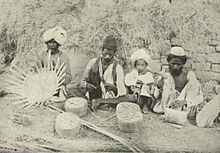
Panjabi Basketmakers, c. 1905
Basketry exists throughout the Indian subcontinent. Since palms are found in the s, handbasket weaving with this material has a long tradition in Tamil Nadu and surrounding states.[ citation needed ]
East asia [edit]
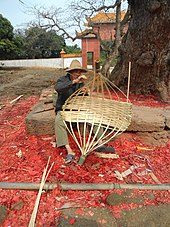
Basket making in Hainan, China. The cloth is bamboo strips.
Chinese bamboo weaving, Taiwanese bamboo weaving, Japanese bamboo weaving and Korean bamboo weaving go back centuries. Bamboo is the prime number material for making all sorts of baskets, since it is the chief cloth that is available and suitable for basketry. Other materials that may be used are ratan and hemp palm.[ citation needed ]
In Nihon, bamboo weaving is registered as a traditional Japanese craft ( 工芸 , kōgei ) with a range of fine and decorative arts.[ citation needed ]
Southeast Asia [edit]
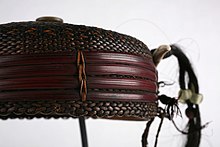
Southeast Asia has thousands of sophisticated forms of indigenous basketry produce, many of which use ethnic-endemic techniques. Materials used vary considerably, depending on the ethnic grouping and the basket fine art intended to exist made. Bamboo, grass, assistant, reeds, and trees are common mediums.[nineteen] [20] [21]
Oceania [edit]
Polynesia [edit]
Basketry is a traditional practice across the Pacific islands of Polynesia. Information technology uses natural materials like pandanus, coconut fibre, hibiscus fibre, and New Zealand flax according to local custom. Baskets are used for nutrient and general storage, conveying personal appurtenances, and fishing.[ commendation needed ]
Australia [edit]
Basketry has been traditionally practised by the women of many Ancient Australian peoples across the continent for centuries.[22] [23] [24]
The Ngarrindjeri women of southern South Commonwealth of australia have a tradition of coiled basketry, using the sedge grasses growing near the lakes and mouth of the Murray River.[25]
The fibre basketry of the Gunditjmara people is noted as a cultural tradition, in the Earth Heritage Listing of the Budj Bim Cultural Mural in western Victoria, Australia, used for carrying the brusque-finned eels that were farmed by the people in an extensive aquaculture system.[26]
North America [edit]
Native American Basketry [edit]
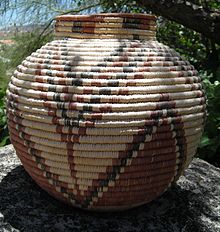
Native Americans traditionally brand their baskets from the materials available locally.
Chill and Subarctic [edit]
Arctic and Subarctic tribes employ body of water grasses for basketry. At the dawn of the 20th century, Inupiaq men began weaving baskets from baleen, a substance derived from whale jaws, and incorporating walrus ivory and whale bone in basketry.
Northeastern [edit]

Handmade kudzu basket made in the Appalachian Oriole style
In New England, they weave baskets from Swamp Ash. The forest is peeled off a felled log in strips, following the growth rings of the tree. Maine and Smashing Lakes tribes use black ash splints. They also weave baskets from sweetness grass, as practise Canadian tribes. Birchbark is used throughout the Subarctic, by a broad range of tribes from Dene to Ojibwa to Mi'kmaq. Birchbark baskets are often embellished with dyed porcupine quills. Some of the more notable styles are Nantucket Baskets and Williamsburg Baskets. Nantucket Baskets are large and bulky,[ citation needed ] while Williamsburg Baskets tin can be any size, and then long every bit the two sides of the basket bow out slightly and get larger equally it is woven upwardly.
- Kelly Church (Grand Traverse Ring of Ottawa and Chippewa Indians)
Southeastern [edit]
Southeastern tribes, such equally the Atakapa, Cherokee, Choctaw, and Chitimacha, traditionally utilise split river pikestaff for basketry. A particularly difficult technique for which these tribes are known is double-weave or double-wall basketry, in which each basketry is formed by an interior and exterior wall seamlessly woven together. Doubleweave, although rare, is nonetheless practiced today, for instance by Mike Dart (Cherokee Nation).[27]
- Rowena Bradley (Cherokee Nation)
- Mike Sprint (Cherokee Nation)
Northwestern [edit]
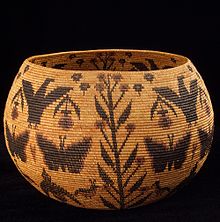
Northwestern tribes apply spruce root, cedar bawl, and swampgrass. Ceremonial basketry hats are particularly valued by Northeast tribes and are worn today at potlatches. Traditionally, women wove basketry hats, and men painted designs on them. Delores Churchill is a Haida from Alaska who began weaving in a time when Haida basketry was in decline, just she and others have ensured it will continue past teaching the adjacent generation.
- Delores Churchill (Haida)
- Joe Feddersen (Colville)
- Boeda Strand (Snohomish)
Californian and Great Basin [edit]

Native American basketweavers working in San Rafael, California in 2015
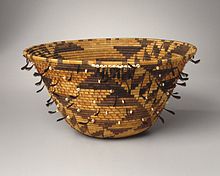
Pomo people girl'south coiled dowry or puberty handbasket (kol-chu or ti-ri-bu-ku), tardily 19th century
Indigenous peoples of California and Great Basin are known for their basketry skills. Coiled baskets are specially mutual, woven from sumac, yucca, willow, and basket rush. The works past Californian handbasket makers include many pieces in museums.
- Elsie Allen (Pomo people)
- Mary Knight Benson (Pomo people)
- William Ralganal Benson (Pomo people)
- Carrie Bethel (Mono Lake Paiute)
- Loren Bommelyn (Tolowa)
- Nellie Charlie (Mono Lake Paiute/Kucadikadi)
- Louisa Keyser "Dat So La Lee" (Washoe people) is arguably the most famous Native American weaver.[28]
- Lena Frank Dick (1889-1965) (Washoe people) followed behind Keyser past ane generation, and her baskets were frequently mistaken for Keyser'due south.[28]
- Fifty. Frank (Tongva-Acagchemem)
- Mabel McKay (Pomo people)
- Essie Pinola Parrish (Kashaya-Pomo)
- Lucy Telles (Mono Lake Paiute - Kucadikadi)
Southwestern [edit]
- Annie Antone (Tohono O'odham)
- Damian Jim (Navajo)
- Terrol Dew Johnson (Tohono O'odham)
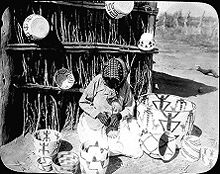
Traditional Tohono O'odham basketmaking, 1916
Mexico [edit]
In northwestern Mexico, the Seri people continue to "sew" baskets using splints of the limberbush plant, Jatropha cuneata.[ citation needed ]
Other North American Basketry [edit]
- Matt Tommey is a Northward American artist who weaves sculptural baskets out of kudzu.[29]
- Mary Jackson is a world-famous African-American sweetgrass basket weaver. In 2008, she was named a MacArthur Swain for her basket weaving.[30]
Europe [edit]
Africa [edit]
Senegal [edit]
Wolof baskets are a coil handbasket created by the Wolof tribe of Senegal.[31] These baskets is considered a women'southward arts and crafts, which have been passed across generations.[32] The Wolof baskets were traditionally made past using thin cuts of palm frond and a thick grass chosen njodax; still contemporary Wolof baskets frequently incorporate plastic as a replacement for the palm fronds and/or re-utilise of discarded prayer mat materials.[32] These baskets are strong and used for laundry hampers, planters, bowls, rugs, and more.[32]
South Africa [edit]
Zulu baskets are a traditional arts and crafts in the KwaZulu-Natal province of South Africa and were used for utilitarian purposes including holding water, beer, or food; the baskets can take many months to weave.[33] [34] Starting in the late 1960s, Zulu basketry was a dying fine art form due to the introduction of tin and plastic water containers.[34] Kjell Lofroth, a Swedish government minister living in Due south Africa, noticed a decline in the local crafts, and after a drought in the KwaZulu-Natal province and he formed the Vukani Arts Association (English: wake upwards and get going) to financially support single women and their families.[34] In this fourth dimension period of the late 1960s, just iii elderly women knew the craft of Zulu basket weaving just considering of the Vukani Arts Clan they taught others and revived the fine art.[34] Beauty Ngxongo is the most renowned living Zulu handbasket weaver.[35] [34]
Zulu telephone wire baskets are a contemporary craft.[36] These are often brightly colored baskets and made with telephone wire (sometimes from a recycled source), which is a substitute for native grasses.[36]
See likewise [edit]
- Native American handbasket weavers
- Basketry of Mexico
- Elizabeth Hickox
- Fully feathered basket
- Pecos Classification
- Putcher
- Sebucan
- Underwater basket weaving
- Willow Human being
- Withy
- Easter basket
References [edit]
- ^ Verhoeven, M. (2000). "The small finds". In Verhoeven, Thou.; Akkermans, P.Grand.M.Yard. (eds.). Tell Sabi Abyad Ii: The Pre-Pottery Neolithic B Settlement. Leiden and Istanbul: Nederlands Historisch-Archaeologisch Instituut. pp. 91–122.
- ^ Wendrich, W.; Ryan, P. (2012). "Phytoliths and basketry materials at Çatalhöyük (Turkey): timelines of growth, harvest and objects life histories". Paléorient. 38 (38.1–2): 55–63. doi:10.3406/paleo.2012.5458.
- ^ a b Schick, T. (1988). Bar-Yosef, O.; Alon, D. (eds.). "Nahal Hemar Cave: Basketry, Cordage and Fabrics". 'Atiqot. 18: 31–43.
- ^ Crowfoot, E. (1982). "Textiles, Matting and Basketry". In Kenyon, K. (ed.). Excavations at Jericho IV. British School of Archaeology in Jerusalem. pp. 546–550.
- ^ Kirkbride, D. (1967). "Beidha 1965: An Acting Report". Palestine Exploration Quarterly. 99 (1): 5–13. doi:10.1179/peq.1967.99.1.5.
- ^ Nieuwenhuyse, O.P.; Bartl, K.; Berghuijs, K.; Vogelsang-Eastwood, M.Grand. (2012). "The cord-impressed pottery from the Tardily Neolithic Northern Levant: Instance-study Shir (Syrian arab republic)". Paléorient. 38 (38): 65–77. doi:10.3406/paleo.2012.5459.
- ^ Duistermaat, K. (1996). "The seals and sealings". In Akkermans, P.M.M.M. (ed.). Tell Sabi Abyad: The Belatedly Neolithic Settlement. Leiden and Istanbul: Nederlands Historisch-Archaeologisch Instituut. pp. 339–401.
- ^ a b Bader, N.O. (1993). "Tell Maghzaliyah. An Early on Neolithic Site in Northern Iraq". In Yoffee, N.; Clark, J.J. (eds.). Early Stages in the Evolution of Mesopotamion Civilisation. Soviet Excavations in Northern Iraq. London and Tucson: University of Arizona Press. pp. 7–40.
- ^ Kirkbride, D. (1972). "Umm Dabaghiyah 1971: A preliminary study". Iraq. 34 (34): 3–15. doi:10.2307/4199926. JSTOR 4199926.
- ^ Broman Morales, V. (1990). "Figurines and other dirt objects from Sarab and Cayönü". In Braidwood, 50.S.; Braidwood, R.J.; Howe, B.; Reed, C.A.; Watson, P.J. (eds.). Prehistoric Archaeology Along the Zagros Flanks. Chicago: Oriental Institute Publications. pp. 369–426.
- ^ Adovasio, J.M. (1975). "The Cloth and Basketry Impressions from Jarmo". Paléorient. 3 (3): 223–230. doi:10.3406/paleo.1975.4198.
- ^ Hole, F.K.V.; Neely, J. (1969). Prehistory and Human being Environmental of the Deh Luran Plain. Ann Arbor: University of Michigan.
- ^ a b c Erdly, Catherine. "History". Basket Weaving. Archived from the original on 2007-09-28. Retrieved 2008-05-08 .
- ^ Diamond, Jared M. (2005). Guns, Germs, and Steel : The fates of homo societies. New York: West. W. Norton & Company, Inc. p. 261. ISBN978-0-393-06131-4.
Nomadic hunter-gatherers are express to technology that tin be carried....You tin't exist encumbered with pottery and printing presses as you shift camp....For case, the earliest attested precursors of ceramics are fired clay figurines made in the area of modern Czechoslovakia 27,000 years agone, long before the oldest known fired clay vessels (from Japan 14,000 years ago)....the oldest known basket appears around thirteen,000 years ago
- ^ "Oldest woven basket in the earth plant in State of israel, dates back 10,000 years". The Jerusalem Post | JPost.com . Retrieved twenty March 2021.
- ^ Lynch, Kate. "From cradle to grave: willows and basketmaking in Somerset". BBC. Retrieved 2008-05-09 .
- ^ Seymour, John (1984). The Forgotten Arts A practical guide to traditional skills. page 54: Angus & Robertson Publishers. p. 192. ISBN0-207-15007-nine.
{{cite book}}: CS1 maint: location (link) - ^ How I turned a mortiferous plant into a thriving concern, Achenyo Idachaba, TED, May 2015, Retrieved 29 Feb 2016
- ^ Philippine basketry: an appreciation, RF Lane - 1986
- ^ Basketry Weaves and Bau-Malay Earthenware Pottery in Southeast Asia. WG Solheim II - Hukay, 2005
- ^ Weaving traditions from Island Southeast Asia: Historical Context and Etnobotanical noesis. D Novellino, 2006
- ^ "Nearly weaving". Maningrida. one March 2017. Retrieved 25 Jan 2020.
- ^ "History of Aboriginal and Torres Strait Islander textiles". archive.maas.museum. 9 April 2017. Retrieved 25 January 2020.
- ^ Mills, Vanessa (21 July 2011). "Weaving magical baskets and sharing Aboriginal knowledge". ABC Kimberley. Australian Dissemination Corporation. Retrieved 25 January 2020.
- ^ "Ngarrindjeri basket weaving". Sustainable Communities SA. 24 August 2016. Retrieved 25 January 2020.
- ^ "Budj Bim Cultural Mural". UNESCO World Heritage Convention . Retrieved 18 March 2020.
- ^ Cherokee basketry artist to be featured at Coffeyville gathering. News from Indian Country. 2008 (retrieved 23 May 2009)
- ^ a b "Washoe Basket Weavers | 1". world wide web.onlinenevada.org . Retrieved 2021-10-29 .
- ^ "Weaving Kudzu into Art". Garden & Gun. 2016-11-28. Retrieved 2021-10-29 .
- ^ "A Lowcountry Legend: Mary Jackson". Garden & Gun . Retrieved 2021-10-29 .
- ^ Sallah, Tijan K. (1995-12-xv). Wolof: (Senegal). The Rosen Publishing Group, Inc. p. 49. ISBN978-0-8239-1987-ane.
- ^ a b c Nevins, Debbie; Berg, Elizabeth; Wan, Ruth (2018-07-xv). Senegal. Cavendish Foursquare Publishing, LLC. p. 101. ISBN978-ane-5026-3642-3.
- ^ "Lidded Handbasket ca. 1990". The Metropolitan Museum of Art . Retrieved 2022-03-29 .
- ^ a b c d eastward Strickland, Carol (2012-12-13). "How Basketry Preserved a People". Christian Science Monitor. ISSN 0882-7729. Retrieved 2022-03-29 .
- ^ Chemaly, Tracy Lynn (July vii, 2021). "Beauty Ngxongo: Woven in Time". TLmagazine . Retrieved 2022-03-29 .
- ^ a b Arment, David; Fick-Jordan, Marisa; Cerino, Andrew (2005). Wired: contemporary Zulu telephone-wire baskets. South/C Editions. p. 49.
Further reading [edit]
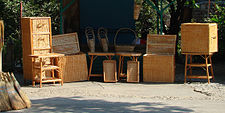
- Blanchard, One thousand. One thousand. (1928) The Basketry Book. New York: Charles Scribner'due south Sons
- Bobart, H. H. (1936) Basket Work through the Ages. London: Oxford University Press
- Okey, Thomas (1930) A Basketful of Memories: an autobiographical sketch. London: J. K. Paring
- Okey, Thomas (1912) An Introduction to the Art of Basket-making. (Pitman's Handwork Serial.) London: Pitman
- Wright, Dorothy (1959) Baskets and Basketry. London: B. T. Batsford
External links [edit]
| | Wikimedia Eatables has media related to Basketry. |
- California Indian Basketweavers Clan
- The National Basketry System
- The Book of English Trades, and Library of the Useful Arts, page 17-22
- Handbook of American Indians North of Mexico. 5. 1/4, folio 132-135
- Spons' Workshop: Handbasket hand-making
- Native Paths: American Indian Art from the Collection of Charles and Valerie Diker, an exhibition catalog from The Metropolitan Museum of Fine art (bachelor as PDF), with material on basket weaving
daughertyharioned49.blogspot.com
Source: https://en.wikipedia.org/wiki/Basket_weaving
0 Response to "Basketry Is a Type of Fiber Art True or False"
Postar um comentário